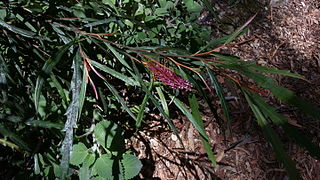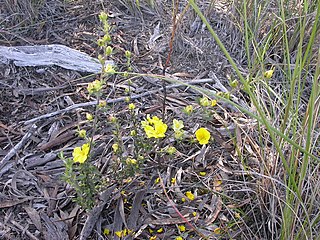
Grevillea longifolia, the fern-leaf spider flower, is a plant of the family Proteaceae, formerly known as Grevillea aspleniifolia. Commonly growing in the Sydney basin of central New South Wales, Australia Grevillea longifolia is recognizable by its deep red "toothbrush" flowers which appear in spring, and narrow, sawtoothed leaves. It is fairly readily grown in gardens.

Hibbertia, commonly known as guinea flowers, is a genus of flowering plants in the family Dilleniaceae. They are usually shrubs with simple leaves and usually yellow flowers with five sepals and five petals. There are about 400 species, most of which occur in Australia but a few species occur in New Guinea, New Caledonia, Fiji and Madagascar.

Persoonia longifolia, commonly known as snottygobble, is a species of flowering plant in the family Proteaceae and is endemic to the southwest of Western Australia. It is a shrub or small tree characterised by its weeping foliage, yellow flowers and distinctive flaky bark.

Banksia prolata is a species of bushy shrub that is endemic to Western Australia. It has linear, serrated or pinnatifid leaves, yellow flowers in heads of between 150 and 250, and egg-shaped follicles.

Hibbertia scandens, the snake vine, climbing guinea flower, golden guinea vine or gold guinea plant, is a species of flowering plant in the family Dilleniaceae, native to Australia but widely cultivated. Growing to 4 m (13 ft) in length, it is a climbing or sprawling evergreen shrub with glossy leaves and solitary, bright yellow flowers.
Banksia prolata subsp. archeos is a subspecies of Banksia prolata. It was known as Dryandra longifolia subsp. archeos until 2007, when Austin Mast and Kevin Thiele sunk all Dryandra into Banksia. Since the name Banksia longifolia had already been used, Mast and Thiele had to choose a new specific epithet for D. longifolia and hence for this subspecies of it. As with other members of Banksia ser. Dryandra, it is endemic to the South West Botanical Province of Western Australia.
Banksia prolata subsp. calcicola is a subspecies of Banksia prolata. It was known as Dryandra longifolia subsp. calcicola until 2007, when Austin Mast and Kevin Thiele sunk all Dryandra into Banksia. Since the name Banksia longifolia had already been used, Mast and Thiele had to choose a new specific epithet for D. longifolia and hence for this subspecies of it. As with other members of Banksia ser. Dryandra, it is endemic to the South West Botanical Province of Western Australia.
Banksia prolata subsp. prolata is a subspecies of Banksia prolata. It was known as Dryandra longifolia subsp. longifolia until 2007, when Austin Mast and Kevin Thiele sunk all Dryandra into Banksia. Since the name Banksia longifolia had already been used, Mast and Thiele had to choose a new specific epithet for D. longifolia and hence for this subspecies of it. As with other members of Banksia ser. Dryandra, it is endemic to the South West Botanical Province of Western Australia. As an autonym, it is defined as encompassing the type material of the species.

Lomandra longifolia, commonly known as spiny-head mat-rush, spiky-headed mat-rush or basket grass, is a perennial, rhizomatous herb found throughout eastern Australia. The leaves are 40 cm to 80 cm long, and generally have a leaf of about 8 mm to 12 mm wide. It grows in a variety of soil types and is frost, heat and drought tolerant. Labillardiere described Lomandra longifolia from a specimen collected in Tasmania.

Hibbertia hypericoides, commonly known as yellow buttercups, is a small shrub species that is endemic to the south-west of Western Australia. It grows to between 0.2 and 1 metre high and has yellow flowers which appear between April and December in the species' native range.

Hibbertia grossulariifolia is a prostrate shrub species that is endemic to the south-west of Western Australia. It spreads up to 1.2 metres in diameter and has yellow flowers which appear between August and December in the species' native range.

Hibbertia obtusifolia, commonly known as hoary Guinea-flower, is a small shrub species that is native to south-eastern Australia. It grows to 60 cm high and has yellow flowers that appear in spring and summer.

Hibbertia riparia, commonly known as erect guinea-flower, is a small shrub that is native to Australia. It grows to 60 cm high and has yellow flowers which appear in spring and summer.

The Burrinjuck Nature Reserve is a protected nature reserve on the south west slopes of New South Wales, Australia. The 5,250-hectare (13,000-acre) reserve is located adjacent to the Burrinjuck Dam, with 5,118 hectares of the reserve located on the northern side of the reservoir, and the remaining 89 hectares located on the southern side of the reservoir to the northeast of Black Andrew Nature Reserve. It includes land formerly managed as the Burrinjuck State Forest and Burrinjuck State Recreation Area.

The Black Andrew Nature Reserve is a protected nature reserve located on the south west slopes of New South Wales, Australia. The 1,559-hectare (3,850-acre) reserve is situated on the southern shore of Burrinjuck Dam on the Murrumbidgee River, an important reservoir for the Murrumbidgee Irrigation Area.

Lomatia arborescens, commonly known as smooth lomatia or tree lomatia, is a shrub or small tree that grows at high altitudes, in and near rainforests. It is found north from the Barrington Tops area in eastern Australia.

Petrophile longifolia, commonly known as the long-leaved cone bush is a shrub which is native to the south west of Western Australia, growing between the city of Albany and the Stirling Range.
Hibbertia ambita is a species of flowering plant in the family Dilleniaceae and is endemic to a restricted area of Western Australia. It was first formally described in 2019 by Kevin Thiele in Australian Systematic Botany from specimens he collected near Boddington in 2015. The specific epithet (ambita) means "encircling" or "surrounding", referring to the arrangement of the stamens around the carpels. This hibbertia is only known from the Jarrah Forest biogeographic region in the south-west of Western Australia.
Hibbertia basaltica, commonly known as basalt guinea flower, is a species of flowering plant in the family Dilleniaceae and is endemic to Tasmania. It is a prostrate or low-lying subshrub with linear to oblong leaves and yellow flowers with five or six stamens arranged in a two groups on either side of the two carpels.












